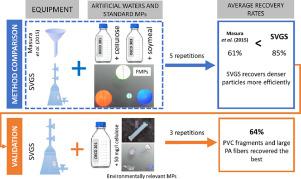Water Research ( IF 11.4 ) Pub Date : 2021-07-05 , DOI: 10.1016/j.watres.2021.117409 Áron Mári 1 , Gábor Bordós 2 , Szilveszter Gergely 3 , Mónika Büki 3 , Judit Háhn 4 , Zoltán Palotai 1 , Gabriella Besenyő 3 , Éva Szabó 3 , András Salgó 3 , Balázs Kriszt 4 , Sándor Szoboszlay 4

|
The global presence of microplastics in the environment is well documented nowadays. Studies already showed the potential risks that microplastic particles might cause to the ecosystem, while potential human health effects are currently under investigation. As one of the main inputs of these crucial researches, the concentration of microplastics in the environment should be measured precisely, confidently and monitored regularly to determine exposure levels of these pollutants. Some study highlights, that the results are usually inconsistent and uncertain, due to different sampling and sample preparation methods and the lack of quality assurance and quality control of these processes. The need for a standardized methodology is an emerging issue, as this would provide the right tools to establish a global monitoring system of microplastics.
Validated sample preparation methods of water (especially freshwater) samples for microplastic analysis are rarely described. To fulfil the gap, this study aims to create and validate a special toolset and the related standard operating procedure for enhanced sample preparation. A newly developed equipment, the Small Volume Glass Separator was designed to easily isolate microplastics from freshwater samples and concentrate the treated sample in a small volume, thus reducing the brine solution use and the sample transfer steps. These features enable better prevention of contamination and making sample preparation easy, fast and cost-effective. The Small Volume Glass Separator and the related standard operation procedure was validated on model freshwater and wastewater samples with the use of fluorescently tagged microplastics and environmentally relevant microplastics (fragments, fibres). Recoveries were measured with optical microscopy under UV light and with near-infrared spectroscopy/microscopy. Recovery tests with fluorescently tagged microspheres showed that average recovery with the Small Volume Glass Separator is 12-39% higher than that of a widespread sample preparation method. This procedure was also able to recover on average 64%±29% of all the environmentally relevant particles during the validation process. Results show that size and density have a great influence on potential particle loss. Recovery of smaller particles are less with both methods than that of the larger particles, but Small Volume Glass Separator yielded significantly higher recovery for more dense particles. The results of this study help to better understand particle loss during sample preparation and thus contribute to the establishment of standardised microplastic analysis processes.
中文翻译:

淡水样品微塑料样品制备方法的验证
如今,微塑料在环境中的全球存在已得到充分证明。研究已经表明微塑料颗粒可能对生态系统造成潜在风险,而目前正在调查对人类健康的潜在影响。作为这些重要研究的主要投入之一,应准确、自信地测量环境中微塑料的浓度并定期监测,以确定这些污染物的暴露水平。一些研究强调,由于不同的取样和样品制备方法以及这些过程缺乏质量保证和质量控制,结果通常不一致和不确定。对标准化方法的需求是一个新兴问题,因为这将为建立全球微塑料监测系统提供正确的工具。
用于微塑料分析的水(尤其是淡水)样品的经过验证的样品制备方法很少被描述。为了填补这一空白,本研究旨在创建和验证一个特殊的工具集和相关的标准操作程序,以增强样品制备。一种新开发的设备,小体积玻璃分离器,旨在轻松地从淡水样品中分离微塑料,并将处理过的样品浓缩到小体积中,从而减少盐水溶液的使用和样品转移步骤。这些功能可以更好地防止污染并使样品制备变得简单、快速且经济高效。使用荧光标记的微塑料和与环境相关的微塑料(碎片、纤维)对模型淡水和废水样本验证了小体积玻璃分离器和相关标准操作程序。在紫外光下用光学显微镜和近红外光谱/显微镜测量回收率。荧光标记微球的回收率测试表明,小体积玻璃分离器的平均回收率比广泛使用的样品制备方法高 12-39%。该程序还能够在验证过程中回收平均 64%±29% 的所有环境相关颗粒。结果表明,尺寸和密度对潜在的颗粒损失有很大影响。两种方法对较小颗粒的回收率均低于较大颗粒的回收率,但小体积玻璃分离器对密度较大的颗粒的回收率明显更高。这项研究的结果有助于更好地了解样品制备过程中的颗粒损失,从而有助于建立标准化的微塑料分析流程。











































 京公网安备 11010802027423号
京公网安备 11010802027423号